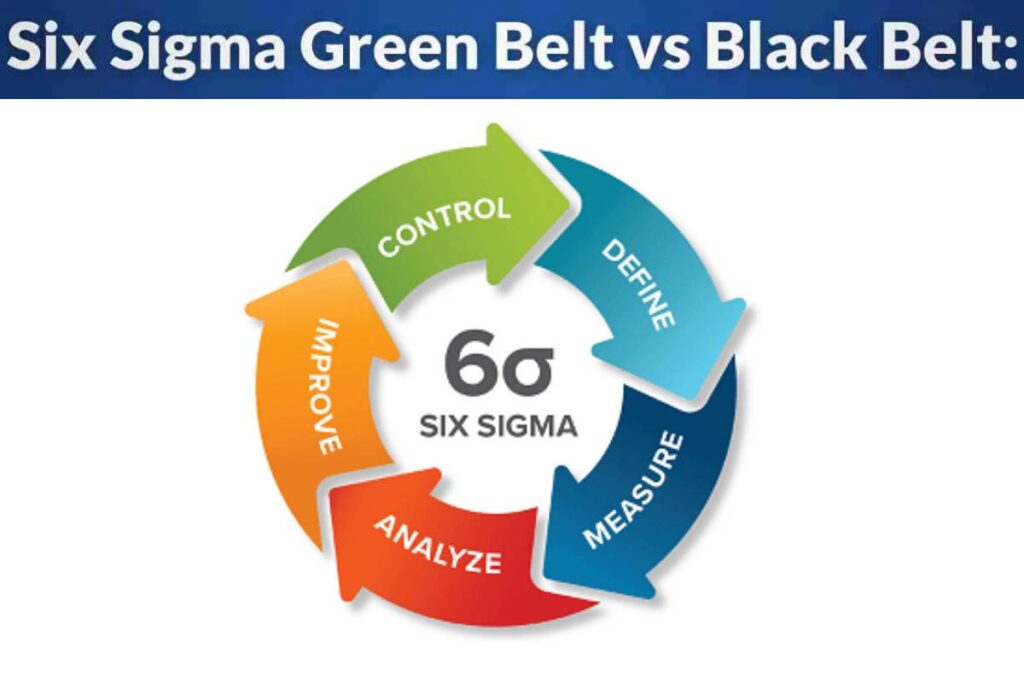In the competitive business landscape of today, efficiency, quality, and continuous improvement are essential for any organisation. From manufacturing to healthcare, IT, and finance, the ability to optimize procedures and shrink waste has a direct bearing on overall profitability and client satisfaction.
It is for this reason that professionals across the globe are pursuing Six Sigma certifications to establish their careers in process improvement and be involved in quality management.
Six Sigma has two well-known levels: the Six Sigma Green Belt and Black Belt. The two certificate options are not equivalent, and they do not provide the same roles, responsibilities, or career trajectories. Your choice between them will depend largely on where you are in your career, how much time you can commit, and the kind of role to which you aspire.
Here, we’ll clarify the difference between Six Sigma Green Belt and Black Belt certifications, what those skills look like in practice, career options, earning potential, and where they both fit into a larger quality management course pathway.
What Is Six Sigma?
Six Sigma is a data-oriented method for improving processes and customer satisfaction through the minimisation of waste or defects. A structured approach, DMAIC (Define, Measure, Analyse, Improve, Control), is used to solve business problems.
Six Sigma has different belt levels (White, Yellow, Green, Black, and Master Black Belt), which represent awareness, responsibilities, and leadership in quality improvement activities.
Six Sigma Green Belt: Overview
The Six Sigma Green Belt certification is for those who want to get involved in process improvement projects, but still focus on other job duties.
- Green Belts assist Black Belts in larger projects and usually take care of minor assignments on their own.
- They possess skills such as troubleshooting, process mapping, statistical analysis, and root cause analysis.
- Training programs last 2–3 weeks, often part-time, making it manageable for early- or mid-career professionals.
- They serve as Six Sigma project leaders in their companies, implementing tools for process analysis and promoting cross-functional teamwork.
Six Sigma Black Belt: Overview
The Black Belt is a more advanced level in Six Sigma.
- Black Belts are project leaders for major improvement projects and coaches for Green Belts.
- They learn advanced statistical techniques, financial impact analysis, leadership, and change management.
- Training is comprehensive and takes 1–3 months with a greater commitment.
- Black Belts typically drive enterprise-level projects with significant profitability and strategic impact.
- They are mid- to senior-level leaders or consultants guiding organizations toward operational excellence.
Differences Between Green Belt and Black Belt
- Green Belts: Focus on tactical, departmental solutions. They collect data, review systems, and initiate smaller changes alongside their main roles.
- Black Belts: Drive strategic, organization-wide improvements. They oversee large projects, mentor Green Belts, and deliver measurable business results.
Skills You’ll Learn
Six Sigma Green Belt Skills
- Problem-solving with structured approaches
- Root cause analysis (5 Whys, Fishbone diagrams)
- Process mapping and workflow evaluation
- Collecting and interpreting performance data
- Elementary statistics: Pareto analysis, control charts, histograms
Six Sigma Black Belt Skills
- Mastery of DMAIC and DFSS
- Advanced analytics (regression, hypothesis testing)
- Design of Experiments (DOE) for optimization
- Leadership and change management
- ROI and financial impact analysis
- Coaching and mentoring Green Belts
Career Opportunities
Green Belt Roles
- Process Improvement Specialist
- Quality Analyst
- Operations Manager
- Business Process Engineer
- Project Coordinator
Black Belt Roles
- Six Sigma Consultant
- Process Excellence Manager
- Quality Assurance Director
- Lean Six Sigma Program Leader
- Operations Excellence Consultant
Salary Outlook
- Green Belt: $70,000–$100,000 per year (depending on industry and experience)
- Black Belt: $100,000–$135,000+ per year, with senior leaders earning more
Higher salaries reflect the leadership scope and strategic impact of Black Belts.
Green Belt or Black Belt? – How to Choose
Choose Green Belt if:
- You are new to quality management or process improvement
- You want to contribute to projects while maintaining daily job duties
- You prefer shorter training durations
- You want a foundation before advancing to Black Belt
Choose Black Belt if:
- You already hold Green Belt experience or certification
- You aim for leadership in quality or operations
- You want to lead company-wide programs with significant financial impact
- You’re prepared for intensive, extended training
Six Sigma and Quality Management Courses
- Green Belt: Equips you with statistical and problem-solving skills for departmental improvements
- Black Belt: Focuses on leadership, advanced statistics, and enterprise-wide strategy
- Both can be combined with quality management courses (TQM, Lean, ISO) for maximum impact
Green Belt as a Step Toward Black Belt
Six Sigma certifications follow a progression.
- Green Belt builds foundational skills and small project leadership
- Black Belt builds on that foundation with advanced analytics, leadership, and cross-enterprise influence
This staged approach eases the transition to greater responsibility.
Conclusion
Both Six Sigma Green Belt and Black Belt certifications add immense career value.
- Green Belt: Ideal for beginners who want to lead smaller projects and gain a foundation in process improvement.
- Black Belt: Suited for experienced professionals aspiring to strategic leadership roles with broader influence.
Ultimately, the choice depends on your career goals, experience level, and leadership readiness. Green Belt is the launchpad, while Black Belt is the transformation into organisational leadership.

